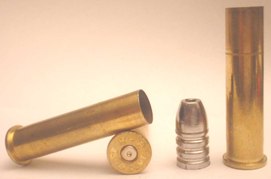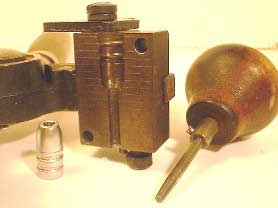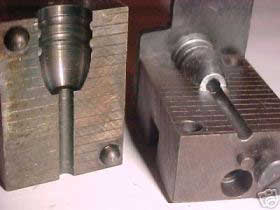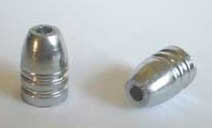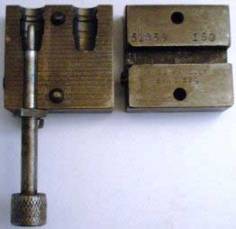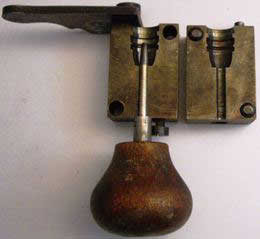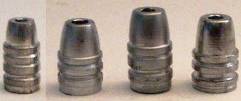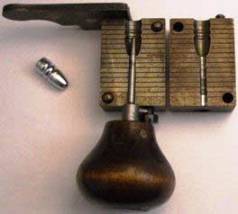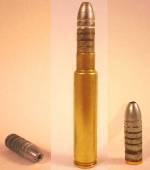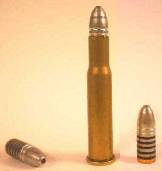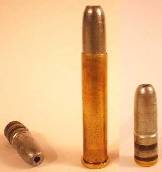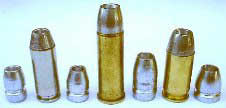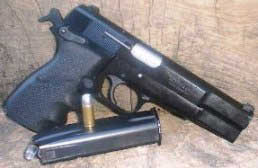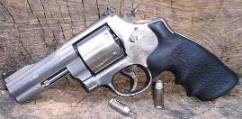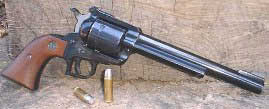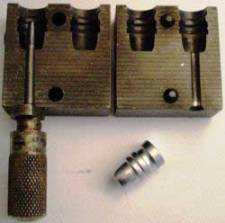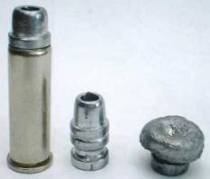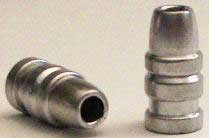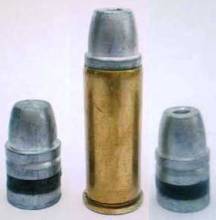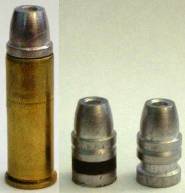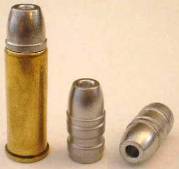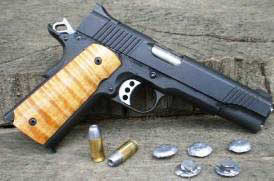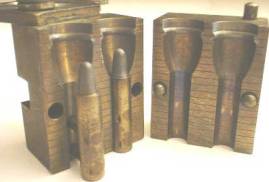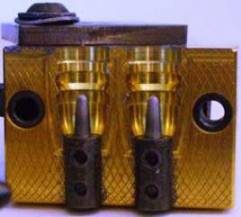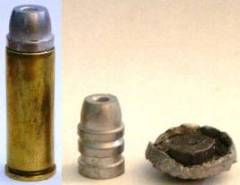|
|
|||||||||||||||||||||||||||||||||||||||||||||||||||||||||||||||||||||||||||||||||
|
Chapter 13 |
|||||||||||||||||||||||||||||||||||||||||||||||||||||||||||||||||||||||||||||||||
|
Casting Hollow Pointed Bullets |
|||||||||||||||||||||||||||||||||||||||||||||||||||||||||||||||||||||||||||||||||
In the original Ideal Handbook (published in 1888), John Barlow summarized his results using cast hollow-pointed bullets for hunting and how the HP cavity enhanced the bullet’s killing effect (showcased with the 330 grain Gould HP for the .45-70). In the low pressure loads of the black powder era, one of the primary goals of the HP cavity was to reduce the bullet's weight, and hence increase muzzle velocity, without changing bullet length. Since the rotational stabilization required for stable bullet flight is (to a first approximation) a function of bullet length, this meant that the twist rate of the barrel didn’t need to be modified to accommodate the lighter faster load ("express load"). This increase in muzzle velocity undoubtedly contributed to the greater killing power of these early HP loads, but the facile expansion behavior of these bullets was clearly an important factor. Bullets of this era were generally quite soft, commonly cast of 30-to-1 alloy (BHN of 7-8) which expands somewhat at typical black powder rifle velocities (1300-1400 fps) anyway, so the expansion of these early rifle HP’s was nothing new (perhaps somewhat more dramatic than what those shooters were used to, but nothing they hadn’t seen before). As the HP cavities got wider and deeper, the expansion became more pronounced and became a property that shooters sought out and exploited (even augmented with percussion caps and .22 blanks, like the Maynard exploding bullet of 1885). While bullet expansion was nothing new to these riflemen, the pistoleros of the day were generally limited to far more pedestrian velocities (typically 700-900 fps) and even 30-to-1 alloy doesn’t expand much at these speeds with typical RN pistol bullets. Thus, the handgunner of the 1890s generally thought basically in terms of bullet diameter, and not so much about bullet expansion. Early experimenters incorporated HP cavities into traditional revolver/lever-gun rounds like the .44-40 (Ideal #42499), and these “express” bullets developed a reputation for “increasing the killing capacity of their rifles by 50%“ (so stated the Ideal Handbook #9, published in 1897). The concept of increasing handgun lethality through enhanced bullet performance (as opposed to just dumping in more powder, or going to a bigger round-nosed bullet) was just starting to take root.
The next major step in terms of handgun bullet performance was the invention of the Keith SWC in 1928. Shortly thereafter, these two enhancements (HP’s and the Keith SWC) were united in Keith's cast HP designs, first with the 359439 (no, that’s not a typo, this HP was given a separate numerical designation from its parent SWC, the 358429) in or around 1932-3, then the 429421 HP and 454424 HP shortly thereafter, and ultimately the 452423 HP. The first three bullets were described in Keith’s 1936 “Sixguns Cartridges and Loads”, and then all four were covered in more detail in his 1956 epic “Sixguns”. Harold Croft and Capt. Frank Frisbie ordered the first 358439, and had it made with a .150” diameter HP cavity (with a 5 degree taper). This bullet proved to be an explosive bullet at .38/44 and .357 Magnum velocities, ideally suited to vermin control (reliable controlled expansion at .38 Special velocities). When Elmer Keith went back to the drawing board for the 429421 HP and 454424 HP, he incorporated .140” and .170” HP cavities (respectively), for thicker walls around the cavities and expansion would be more controlled for hunting larger animals (deer, black bear, elk, etc.) in his +P loads at 1200 and 1100 fps (respectively). A subtle, but nonetheless
important feature of the Keith HP’s is that they all have a tapered cavity (approximately a 5 degree taper), usually with a rounded bottom. This allows the molten alloy to flow smoothly around the HP pin and avoids trapped air pockets. In addition, as expansion progresses towards the bottom of the cavity, this design avoids the formation of stress risers at the bottom of the cavity (no sharp corners), thereby helping the bullet stay intact. The broad meplat of the Keith SWCs bludgeons its way through meat, leaving a deep wound channel with a permanent hole through the middle of the crushed tissue (round nosed bullets crush far less tissue and fail to leave this permanent hole, leaving instead a sphincter-like wound channel that closes up on itself, severely limiting blood loss). The expansion of the Keith HP’s leads to significantly more shredded tissue than does the SWC‘s, leaving a wider wound channel (although they don’t penetrate as deeply as Keith SWC‘s). In my experience, the Keith SWC’s tend to leave a wound channel with 2-3” of bloodshot tissue, with a permanent hole about ˝” across. The Keith HP’s leave as much as 6” of tattered, bloodshot tissue and a permanent hole about an inch across. Sadly the Keith HP moulds are no longer available from Lyman, but they can be found on the used mould market, often commanding premium prices.
As a result of his development of the .357 Magnum cartridge in the 1930s, Phil Sharpe designed his own HP in which he took his inspiration from Keith’s 358439, but with 5/6 the bearing surface (for higher velocities) and a shorter ogive (so as to fit within the short cylinder of the brand new N-frame .357 Magnum). The mould was made by George Hensley and produced a 146 grain HP (Hensley’s #51). Accuracy was found to be excellent and expansion violent at 1500+ fps. The Sharpe HP had straight-walled .100” diameter cavity, with a flat, square-edged bottom. A flat-tipped HP pin can create turbulence when the molten alloy is poured, trapping air bubbles in the bullet, so it is important to cast fast and hot with such a mould. In addition, the flat bottomed HP cavity of the Sharpe HP focuses stress at the corners of the cavity during expansion, leading to shear at this juncture, making this HP design more prone to fragmentation (which may explain why Sharpe went with a smaller cavity diameter). The original Lyman/Ideal HP’s were standard mould blocks simply drilled to allow entry of the HP pin, with no provision for holding the pin in place other than friction, nor was there any way to be sure that the pin would be held at the same depth for each pour. George Hensley solved this problem by devising a cleverly milled collar that addressed both issues very effectively and he used this design for all the HP moulds made in his shop. In 1941 Lyman modified their design to include the pin/set screw design they used for years. In the latter part of the 20th century, Lyman went to using a simple snap ring to hold the HP spud in place.
After WW II, Douglas Sorenson designed the 40388 HP for the .38-40 (this bullet was also available in solid form). The Sorenson HP was first listed Ideal Handbook #37, published in 1950 (This is another example of a re-issued cherry number, the original #88 was the famous 330 grain 38-55 paper patched target bullet designed by Rabbeth). The .38-40 had a reputation for "hitting hard", and the Sorenson HP was designed in this spirit, but in post-war America the .38-40 cartridge was waning in terms of both popularity and sales. The mould design quickly and quietly faded away, as did the cartridge. It's a shame because this bullet is nothing short of amazing in the Herter's .401 Powermag. 20.0 grains of Accurate Arms #9 produces over 1600 fps and excellent accuracy. This bullet is explosive at 1600 fps!
Ray Thompson also designed a series of HP's right World War II. The Thompson HP’s (and SWC's) were protected by GC's on their bases, and also had narrower lube grooves to accommodate the GC. The .38/.357 designs also came with two crimping grooves so the shooter could load these bullets to .357 OAL's in cheaper and more plentiful (at that time) .38 Special cases. The Thompson GC-SWC designs 358156, 429215, 429244 and 452490 are mainstays in the Lyman product line to this day. An interesting historical sidebar: the Lyman mould numbering scheme identifies the nominal bullet diameter with the first three digits, followed by a sequential design number (or "cherry number"). The Thompson design numbers of 156, 215 and 244 would suggest that they pre-date the Keith designs (421, 423, 424, etc.), when in fact they clearly did not and came along over two decades later. This is an example of cherry numbers that had been dropped from the Lyman/Ideal line that were “recycled” (for example, the original cherry #156 was a 150 grain .32-40 FN bullet, #215 was a 205 grain .44 RN and #244 was an 89 grain RN for the .30 Luger). Rumor has it that Ray Thompson requested these previously dropped design numbers since they were approximately the weight of his .38 and .44 designs (actually, the larger .44 bullet is closer to 260 grains). His 452490 was obviously numbered sequentially. In any event, each of Thompson’s GC-SWC designs was also made in HP form -- 358156 HP, 429244 HP, 429215 HP and 452490 HP (these moulds are encountered today in roughly that order of frequency). Ray Thompson stuck with the same HP pin diameter and design (i.e. tapered and rounded) that Elmer Keith used in the .44 bullet (.140”), but went with a somewhat smaller pin diameter for his .357 HP (.125”), about halfway in between the Keith HP and the Sharpe HP. This leads to a more moderate, controlled expansion of the bullet relative to the 358439. The 358156 HP is still an excellent varmint bullet, but just not as explosive as the 358439 in its expansion behavior. It could easily be argued that the 358156 HP is the most versatile, all-round bullet for the .357 Magnum. While I prefer larger calibers for hunting deer, if I were to use a .357 Magnum for deer, the 358156 HP would be, far and away, my first choice of projectile, jacketed or cast, it's that good. The 429215 HP is an explosive, high velocity varmint bullet out of either the .44 Magnum or .44 Special. The 429244 HP has very similar expansion characteristics to the Keith version (429421 HP), it simply carries a little more weight, and a gas-check. The 452490 was also available in HP form, but can be very hard to find. Both the Thompson and Keith HP’s are excellent hunting bullets. Like the Keith HP’s, the Thompson HP’s have also been dropped by Lyman, but can be found on the used mould market (gun shows, mail order businesses, online auction houses, etc.) In the past, Lyman offered the service of custom cutting HP versions of virtually any mould they offered at the customer’s request (sadly this is no longer true). As a result, one can encounter a little bit of everything when perusing used moulds at gun shows, online, etc. Some of these designs leave you scratching your head, and some are clearly very useful designs. This unexpected joy of discovery is one of the things that makes collecting bullet moulds so much fun!
For example, there is a rather unusually proportioned SWC for .32 caliber revolvers (the 313445) that was a popular target bullet back in the middle part of the 20th century. I stumbled across a HP version of this mould several years ago and gave it a home for no other reason than, well, it was different. The HP cavity is quite narrow (only .078" at its widest point) and shallow (only .270" deep), and as a result expansion is minimal when fired from the .32 S&W Long that it was designed for. Even the higher velocity of the .32 H&R Magnum doesn‘t induce much expansion. However things can get very interesting with this bullet in the .30 Carbine Blackhawk!
Other examples of HP variations of traditional Lyman designs include moulds like their .25-20 bullet (the #257420 HP), and the .32-20 HP mould like the 313316 HP. As a historical aside, it is interesting to note that the 257420, the younger of these two designs, was the cherry number immediately preceding Elmer Keith’s 1928 landmark design for the .44 Special. Small caliber HP’s like these commonly benefit from being force-fed (see casting discussion below).
The advent of the Thompson-Center Contender brought certain bore diameters traditionally thought of as being rifle calibers into the handgunner’s realm. Some of these old Lyman/Ideal HP moulds serve this branch of the hunting community quite well indeed. For example, the Lyman 266455 HP makes a very nice coyote bullet in the 6.5 TCU wildcat cartridge when sized .266"; 28.0 grains of H4895 generates 1850 fps from a 10" Contender and expansion is violent. A 10” .45 Colt Contender is extremely well-served by the 330 grain Gould HP (#457122) sized .454", and is capable of launching this bullet at 1250 fps. In fact, the cast HP can make a given cartridge a legitimate hunter in the Contender when it might not be such when loaded with jacketed bullets. For example, none of the .270 jacketed bullets will expand at .270 Ren velocities, but when loaded with the 280412 HP over 9.0 grains of H110 (1425 fps) the .270 Ren makes a very effective coyote load, and expansion is positive. Another example would be the .30-30 Winchester in a 10” T/C; this gun is something of a fish out of water since the case has too much capacity for good ballistic uniformity with light bullets (hence the advent of the .30 Herrett), but the heavier, more accurate jacketed bullets are going too slow to expand. However the 10“ .30-30 Winchester T/C is an excellent cast bullet gun and a hunting weight cast HP can easily be tailored to expand at the velocities attainable with this gun through judicious choice of alloy, making an excellent load for deer-sized game. The 157 grain 311466 HP loaded over 32.0 grains of H4895 generates right at 1790 fps from a 10" T/C and expansion is violent. Similarly, the .357 Hartley (kind of a .35/.30-30 Ackley Improved, if you will) makes a fine hunting round for deer and black bear sized game in a 10" T/C with the 288 grain Lyman 358009 HP. 32.0 grains of H4895 pushes this behemoth out of short-barreled Contender 1460 fps. Once again, expansion is positive. In each of these cases, the cast HP very nicely "fills in the middle ground" between the velocities that can be reasonably achieved in these short-barreled guns and those needed to make typical jacketed rifle bullets expand, making for very portable and hard-hitting hunting arms. Back in the days that Elmer Keith, Phil Sharpe and Ray Thompson were designing their HP moulds, most bullet casters used binary alloys composed of lead and tin. These malleable alloys were well-suited for HP’s in that they expanded smoothly, and were not prone to brittle fracture. As a result, these bullets were designed with a fairly narrow HP cavity (since the alloys were fairly soft), that extended fairly deeply into the bullet (since they didn’t tend to break up, and a deep cavity led to more expansion). In more recent years, the most common source of bullet metal is wheelweight alloy, which tends to vary somewhat in composition, but generally has 3-4% antimony and roughly 1/2% tin (among other “stuff”). This alloy is of similar hardness to the previously preferred 16-to-1 HP alloy, but is more brittle than it 16-to-1 meaning that when HP’s cast of straight WW alloy expand, they may be more prone to fragmentation (depending on impact velocity). Perfectly usable bullets (SWC’s, RNFP’s, TC’s, etc.) can be cast from straight WW alloy, but trying to cast high quality HP’s from straight WW alloy can be an exercise in frustration (depending on how cantankerous your particular mould is). Adding a small amount of tin to the mix does wonders in terms of casting high quality HP bullets, as well as improving their expansion behavior (see chapter on Alloy Selection). However, there is another strategy that also works very effectively -- change the nature of the HP cavity. By making the HP cavity wider and more conical, the bullet will still expand when cast with antimony containing alloys (like straight WW), and by making the cavity shallower, if the expanded “petals” of the bullet should break off, there is still adequate bullet mass left behind the cavity to punch through the other side of yon critter (much like the concepts behind the Nosler Partition bullet design). This is precisely the tact taken by Lyman when they rejuvenated the concept of the cast
HP by introducing their line of Devastator HP’s back in the 1990’s. This next generation of HP moulds reflects the changing tastes of the American handgunner, and is aimed largely towards semi-auto cartridges; the 9mm, the .40 S&W and 10mm Auto, the .45 ACP, as well as the perennial hunter the .44 Magnum. The HP “spuds” on these moulds are conical, and start off with a “mouth” diameter of .200-250”! In addition, they extend less than .290” into the bullet (as compared with over .410” for the 429421 and 429244 HP pins). As a result, these designs expand very readily when cast of WW alloy, and if the “petals” do break off, so what? There’s still plenty of bullet metal left. In a nutshell, the old Keith and Thompson HP designs were built around malleable alloys of lead and tin. The Devastator HP’s were designed specifically with WW alloy in mind. Times change and Lyman has changed to keep pace.
The 9mm Devastator (Lyman #358637 HP) is simply a 125 grain HP version of their excellent 147 grain RNFP for the 9mm Parabellum, and this HP is clearly a varmint bullet. Note that 22 grains of bullet metal have been removed to generate the HP cavity -- folks, that’s a big hole! For the sake of comparison the Keith and Thompson HP‘s removed about 12-14 grains of alloy to make their HP‘s. Running jack rabbits are a real challenge for the handgunner, and a double-stack magazine 9mm loaded with these bullets is just about ideal for such pursuits. This bullet also serves well in .38 Special varmint loads at 1000 fps.
The 10mm Devastator (Lyman #401638 HP) is also a derivative of their standard mould line, this time a 155 grain HP of their 175 grain TC design (again, 20 grains of bullet metal removed for the cavity). This is an excellent varmint bullet launched from a 6 ˝” S&W 610 at 1374 fps by 11.5 grains of HS-7 (1220 fps from a 3"). Expansion at this velocity is positive and early. This load would be adequate for coyotes, feral dogs, badgers, porcupines, Javelina, etc.
The classic .45 ACP 230 grain RN (Lyman #452374) was modified with a similar flat-nosed HP plug to create the Devastator .45 HP. This HP is listed at 180 grains but they drop from my mould at about 186 grains (44 grains of metal removed!). When launched with 7.5 grains of Unique they deliver right at 1100 fps and very good accuracy from a full-sized Kimber 1911. This bullet feeds quite nicely too. Once again, expansion is positive and early. I also limit use of this big-mouthed bullet to game no larger than 110-120 lbs. Loaded into .45 Schofield cases on top of 7.5 grains of Unique this HP makes a vintage varmint load extraordinaire! The lighter semi-auto Devastator HP’s can be something of a challenge to get a “good mouth” on as a result of the relatively small amount of hot bullet metal going into the cavity to warm up the rather large HP pin. Turning up the pot temperature somewhat helps to counter this, and I have had good success casting at about 750° F or so. The caster can also dunk the pin into the lead pot to pre-heat it. This problem seems to be less of an issue with the much heavier 429640 HP.
The .44 Magnum Devastator is the real hunter of the new generation of HP's. The 429640 HP is a HP version of their now discontinued RNFP design (an excellent bullet that should have never been dropped). When cast with sweetened WW alloy, these HP's drop from the blocks at 260 grains (the parent GC-FP drops from my mould at 284 grains when cast of a similar alloy, revealing the removal of 24 grains of bullet metal to create the cavity; again, these are big holes!). Excellent accuracy is obtained with this HP when loaded over 22.5 grains of W296 and a CCI 350 primer in .44 Magnum cases, developing over 1400 fps from a 7 ˝” Ruger Super Blackhawk. Expansion on mule deer is positive, and as a result of the greater bullet weight of this HP (relative to the lighter semi-auto Devastators) penetration is very good. Deer, black bear, and even elk are fair game for this bullet. This is arguably the single most useful cast bullet on the market today for the American handgun hunter. Lee also makes a line of HP moulds. On the Lee HP’s the HP spud is physically attached to the mould so it can never be lost. Due to the mechanics of how these moulds operate, the HP cavity is by necessity fairly shallow and slightly conical, so the bullets will release readily. For the handgunner, they make various HP moulds in .38, .44 (both GC and PB versions of their SWC designs) and .45 ACP (a PB RN design). Because of their shallow cavities, expansion of the Lee HP’s is rather limited and not as dramatic, but as a result weight retention is good, leading to deeper penetration. Thus, the Lee HP’s offer the handgunner a somewhat different “flavor” of cast HP performance. The Lee HP moulds are not as solidly built as the Lyman moulds, but they are nonetheless moderately serviceable and offer the caster an affordable entry into casting HP’s.
Hensley & Gibbs also offered HP versions of their mould designs. As with all H&G moulds, these were beautifully made. Today, HP H&G moulds are not often encountered and when you do happen across one, it’s usually wearing a steep price tag. Casting High Quality HP’s In order to cast high quality HP bullets, it’s important to remember to do four things; first make sure to use an alloy with at least 2% tin (see chapter on Alloy Selection), secondly, turn the pot temperature up about 50 degrees hotter than normal (750° F or more), thirdly, fill the cavity quickly, and fourthly cast as quickly as is you can comfortably and safely do so. There is a common sentiment that HP moulds are demonically possessed, and that it’s difficult to cast high quality HP bullets. Not true! It IS true that casting HP’s is a slower process than casting SWC’s from a gang mould since the HP mould is a single cavity mould, and requires manual manipulation of the pin with each cast, however if one pays attention to these four points then making high quality HP’s is no more difficult than any other cast bullet. It all comes down to making sure that the molten alloy can fill in around the HP pin completely before solidifying, so let’s go through these issues, point by point. The tin content of the alloy is important to keep viscosity down so the alloy flows quickly and easily around the HP pin (it also lowers the melting point of the alloy so it stays liquid longer). Two percent tin is all that’s really needed to accomplish this, certainly more won’t hurt, but with the cost of tin, why bother? Tin also helps to keep the alloy malleable so the resulting HP mushrooms smoothly instead of fragmenting. Keep the antimony content low, preferably 3% or below to prevent brittleness of the cast HP. Starting with WW alloy and diluting it down with lead-tin alloy, is a good way to do this. Casting a little hotter than normal helps to keep the blocks and pin up to temperature. I normally cast at about 650-700° F, and turn the pot up to about 750° F or so for HP's. HP moulds are commonly single cavity moulds, so there’s only one “bullet’s worth” of hot metal going into the block with each cast. In addition, a HP mould requires extra processing steps (i.e. removing the pin and laying it down, and putting it back in again), so the time between each pour may be a little longer than for a typical 2-cavitymould. Heating the alloy up a little hotter than normal helps to counteract this. This is particularly true for the new Devastator HP’s with their much thicker pins (I cast these at 750-800° F). Fill the mould quickly so the “mouth” of the HP doesn’t get a chance to solidify prematurely (this will create wrinkles and voids in the HP walls and make for an inaccurate bullet). Many HP moulds, but certainly not all, “prefer” to be force-fed (i.e. held in direct contact with the bottom pour spout or ladle). Smaller bullets in particular tend to respond well to force-feeding as it allows for a faster casting pace and helps to keep the mould and pin up to temperature. Whether a given mould prefers to be force-fed or not, the faster the cavity is filled, the higher your percentage of quality HP’s will be. Cast fast! By running as much metal as possible through the mould keeps both the mould blocks and the HP pin hot, and minimizes the amount of time that the HP pin is outside of the mould. The HP pin starts to cool down as soon as it’s removed from the blocks, so a fast casting pace keeps it out of the blocks the shortest amount of time, and exposes it to the most amount of hot bullet metal. A cool HP pin is an unhappy HP pin (you will never get high quality HP’s from a cool HP pin). Do not inspect your HP bullets as you cast! This will only slow down your casting pace, and increase the number of defective bullets. As with any casting session, there will be rejects. Ignore them! Just cast fast! There will be plenty of time at the end of your casting session to sort through your bullets, cull the rejects and dump them back into the lead pot for next time. Cast HP Performance The performance of a cast HP depends on the alloy that the bullet is cast from, cavity diameter, cavity depth, and cavity taper. Thus the caster has the ability of fine-tuning the expansion properties of his load by changing the alloy that the cast are cast with, or (if the caster is a machinist) by making alternate HP pins to change the depth or taper of the cavity. How a HP expands depends on the amount of hydraulic fluid that fills the cavity, and the forces applied by that fluid. So the key variables involved are the diameter and depth of the cavity, and the impact velocity. As the cast HP enters an animal, the body fluids are forced into the HP cavity. The hydraulic pressure acts upon the internal surface area of the cavity, pushing it outward. The more surface area, the more force gets applied. A smaller cavity allows less hydraulic fluid in, and has less surface area for it to press against. A smaller cavity also gives rise to thicker walls in the bullet's nose (for a given bullet diameter), resisting this force more effectively. Therefore, smaller cavities result in slower expansion than do larger cavities. For those HP designs with a relatively large cavity relative to bullet diameter (e.g. the 358439 and the Devastator HP’s), an alloy with a BHN of 11 (e.g. WW alloy sweetened with 2 % tin) provides controlled expansion at 900 fps, and rapid expansion above 1200 fps. Alloys with a BHN of 8 (e.g. 50/50 WW/Pb or 25-to-1) allow smooth expansion down to about 800 fps with these big mouth bullets. For the rest of the Keith and Thompson HP’s, alloys with a BHN of 11 give controlled expansion at 1200 fps, and rapid expansion at 1400. Alloys with a BHN of 8 will provide modest expansion down to about 900 fps. Selected Cast HP Loads Starting with the smaller bores and working up, the .30 Carbine Blackhawk is at its best with the Lyman 313316 HP, a GC-SWC that drops from the blocks at 105 grains when cast with sweetened WW alloy. Loaded over 13.0 grains of AA #9, this bullet leaves a 7 ˝” Blackhawk at almost 1600 fps. This makes for a flat-shooting, hard-hitting varmint load, with violent expansion. Staying with the .32’s, the .32 H&R does very nicely with the 108 grain Ideal 31133 (the hollow point version of the timeless 3118). This PB HP is very accurate when loaded over 6.5 grains of AA #7 for 1100 fps. Peeling rodents off of their mounds from 75 yards is no problem for this load in a 6” S&W Model 16. Once again, expansion is positive when cast to a BHN of about 11 or lower.
Moving to the mid-bores, the .38 Special could fill volumes with accurate cast bullet loads, and it’s equally well-served by cast HP’s. There are three combinations for the .38 Special that have served with distinction. The first, and quite possible the most versatile .38 Special load in existence, would be Elmer Keith’s first HP, the 154 grain Ideal 358439, over 8.5 grains of HS-7 for 1050 fps from a 6” S&W Model 14 (this is a +P load at about 20,000 psi). This is a very accurate load, somewhat similar to the highly regarded “FBI Load”, and it just flattens vermin, even wiry Arizona jack rabbits, right now. Expansion is positive, but not violent or explosive when cast to a BHN of 11 or less. This is simply as good as the .38 Special gets. I have shot many thousands of these rounds and can think of no way to improve it. My second pet load for cast HP’s in .38 Special involves the 358480 HP, a 128 grain SWC-HP. This HP is a little more stoutly constructed than is the 358439 (it has a shallower cavity, surrounded by thicker walls) and must be cast pretty soft in order to expand at .38 Special velocities, so I generally cast it using 25-to-1 alloy. Loading this PB bullet over 4.5 grains of Bullseye generates 1025 fps and makes an excellent small game and varmint load. It’s not terribly destructive, but it’s a clean and efficient killer. The last of my favorite .38 Special loads is the “Johnny come lately” of the group. The old Lyman #358477 (150 grain SWC) has always been a personal favorite, as has Elmer Keith’s HP (#358439), so it should be no surprise that a HP version of the 358477 was a long sought after goal. This can be thought of as revisiting the 146 grain Sharpe HP that was used in the original development of the .357 Magnum (the old 358477 has a very similar profile to the original Sharpe HP, made by George Hensley). Recently, I sat down and did a little lathe work and made just such a mould (after years of fruitless searching, then I found a 358477 HP a couple of months later!). Since this was envisioned as principally being a varmint bullet, the channel was cut at .160” and the pin turned to .158”. The cavity was taken down to the bottom of the crimp groove, terminated with a 5 degree taper, and rounded. One way to think of this bullet is the Sharpe bullet, with a Keith HP pin design. Bullets drop from the mould at 140 grains, and are exceptionally accurate when launched with 4.4 grains of Bullseye (956 fps from a 6" S&W K-38 Masterpiece). At this velocity, expansion is modest when cast of WW alloy, but when cast at BHN of 8 these HP's expand very nicely.
For the .357 Magnum, my list has 4 entries. The time-honored, old stand-by's are either the 358439 or the 358156 HP over 14.0 grains of 2400 for about 1350 out of a 6” S&W 686, or a little over 1400 fps from an 8 3/8” S&W 586. The third entry is more recent, and once again involves the 358477 HP, this time over 15.0 grains of 2400 (for 1571 fps from an 8 3/8", 1502 fps from a 6"). This bullet has the advantage of providing the same kind of explosive performance as the 358439, but it also functions in all .357 Magnum revolvers (the long nose on the 358439 makes it too long for the N-frame .357s and the Colt Python, and requires that it be seated deeply and crimped over the forward driving band and not in the crimp groove). The 358477 HP is very similar to the bullet that was specifically designed for the .357 Magnum at it's birth, and defined a completely new level of handgun performance at 1500 fps in 1935. The fourth entry would be the first magnum HP, the 146 grain H&G #51 HP over 15.0 grains of 2400 for about 1500 fps. This is Phil Sharpe's bullet that started it all back in 1935. The 358439 pre-dates the .357 Magnum, and provided inspiration for the first Magnum in the form of the .38/44 Heavy Duty loads, but the Sharpe HP was designed specifically for the S&W's N-frame cylinders. The Keith and Sharpe HP's ushered in the Era of the Magnum Handgun. All four of these loads are exceptionally accurate, and allow the shooter to pick what level of expansion is desired. The Thompson HP provides a good mix of controlled expansion and penetration. The Keith HP (359439) provides more violent expansion and somewhat less penetration, as does the H&G #51 HP (the Sharpe HP). The 358477 HP just flat explodes at 1500+ fps. To my way of thinking, these bullets define .357 Magnum performance.
The .44 Special is one of my favorite cartridges, and for general plinking there is no finer bullet for the .44 Special than the 429421. For hunting, the 429421 HP is an excellent compliment to its SWC parent. I generally load the .44 Special to “Skeeter Skelton levels” (i.e. about 950 fps and 20,000 psi, as opposed to Elmer Keith’s loads at 1200 fps and 34,000 psi) using either Skeeter’s load of 7.5 grain of Unique, or 10.0 grains of HS-6. Either of these powder charges will deliver about 925 fps from a 4” S&W 624, and will crowd 1000 fps from longer barrels. At these velocities the 429421 HP must be cast pretty soft to expand, generally a BHN of 8 or so. I generally cast these with recovered range scrap (BHN of about 7.5 or 8), but one can get similar results using either range scrap, 1:1 WW/Pb, or 25-to-1 lead/tin. This is usually the load that accompanies me in the mountains during my summer firewood cutting chores.
Ah yes! The .44 Magnum! The huntsman of the handgun clan. From a 7 ˝” Super Blackhawk the 429421 HP can be comfortably launched at 1400+ fps and 1350 fps or so from a 6” S&W 629 Classic Hunter using 23.5 grains of W296. This is a hard-hitting hunting load that I have used with complete satisfaction on critters ranging from prairie dogs to mule deer. The new Devastator HP (the Lyman 429640 HP) shoots extremely well using 22.0 grains of W296 with a CCI 350 primer for 1400+ fps from a 7 ˝” Super Blackhawk, and does a fine job on deer-sized game. Ray Thompson’s HP (the 429244 HP) does very nicely indeed over 23.5 grains of W296 (again, the CCI 350) for about 1300 fps from a 6” S&W 629 (about 1400 fps from a 7 ˝” SBH, and 1750 fps from a 20” Marlin 1894). This is a good bullet in the Marlin lever-gun since it cycles so smoothly, shoots so well and hits like a sledgehammer (the Lyman 429640 certainly has the right ogive for the lever-guns, but the fragile mouth of the HP version gets dented and tends to hang up when cycling the action of my rifle, whereas the 429244 HP feeds much more smoothly). I have a 300 grain HP mould (made from a modified RCBS 44 300 GC-SWC mould) that is my personal favorite in the .44 Mag; it is an excellent hunting bullet and kills hogs very quickly. Any one of these loads would make a fine companion for the handgun hunter in the Lower 48 (assuming the shooter is up to the task).
The .45 ACP is traditionally thought of in terms of a 230 grain RN at around 850 fps, or bullseye loads built around a 200 grain cast SWC at about 750 fps. Nice, but, so what? In more recent years, a number of more sprightly loads have come on the market pushing 185 grain JHP’s to 1100 fps for defensive and law enforcement applications. I wanted to mimic some of these loads using a cast HP for coyote, badger, porcupine, skunks, etc. In my experience, one of the more accurate and reliable bullets in the .45 ACP has been the Lyman 452460, 200 grain SWC. A single cavity 452460 mould was converted to drop HP bullets that weighed 186 grains (see “How to Make HP Moulds” for details). When loaded on top of 7.5 grains of Unique this bullet generates 1121 fps and groups well from an 5" Colt Government Model. When fired into water bottles and ballistic gelatin at this speed, expansion was positive. The 452374 HP also weighs about 185 grains and can be pushed the same speed. It expands easily and cycles smoothly in my 1911’s. My personal favorite is a 452374 2-cavity mould that I had modified by Erik Ohlen, that now drops 210 grain HPs that shoot, cycle and expand perfectly when cast of 25-1 alloy and shot at 965 fps.
For the .45 Colt, the list is once again short and sweet, I like to load
the 454424 HP, cast to a BHN of about 8 using recovered range scrap over
14.0 grains of HS-7 sparked with a CCI 350 primer for 1050 fps and
excellent accuracy. This is my preferred hunting load for my N-frame
.45’s. I am also quite fond of the Keith load (18.5 grains of 2400) with
the Keith HP (~1100 fps). Both are very accurate and will handle
deer-sized game very well indeed. When a little more horsepower is
called for, I turn to the beautiful work of Miha Prevac and cast some
HPs using the Cramer style 2-cavity mould he made for me built around
the Dave Scovill design (RCBS 45-270-SAA). This 280 grain HP loaded
over 13.0 grains of HS-6 gives me 1150 fps from a 7 1/2" Ruger Blackhawk
with excellent accuracy and expansion.
Many of the top handgun hunters (like John Taffin, J. D. Jones, Hal Swiggett, Mark Hampton and others) have gone on record recommending an expanding bullet as the best choice for the handgun hunter when hunting game animals under 400 lbs. We read all these wonderful stories about hard-working handgunners hunting exotic corners of the globe and smashing massive beasts with iron-sighted revolvers launching hardcast heavyweight slugs at tobacco-spitting distances, and we figure, “Well, if that bullet will hammer a 2000 lb Cape buffalo, it’ll handle a 150 lb deer with no problem, and I’ll feel like a big-league stud hunting with such beast-smasher load.” The only problem is, those hardcast heavyweights don’t get a chance to do much damage to a dainty little 150 lb deer before they exit the far side, and so that deer may run a long, long ways before it finally falls to it’s modest wounds. Heavyweight hardcast bullets are best suited to thick-skinned, heavy-boned game, weighing thousands of pounds, that require wound channels 4-6 feet deep to die in a forthright manner. Typical American hunters spend most of their time hunting deer-sized game (and maybe elk), and for these lighter thin-skinned animals an expanding bullet is generally a better choice. The cast HP allows the independent handgunner to make his own expanding bullets and feel the satisfaction of slaying big game animals with ammo that he crafted from its raw materials. Cast HP’s are in no way suited to hunting dangerous game like Asiatic water buffalo, elephant or the big bears, but for thin-skinned game from rodents up through elk there is a cast HP handgun load that will flat do the job, and do it well. |
|||||||||||||||||||||||||||||||||||||||||||||||||||||||||||||||||||||||||||||||||
|
|
|||||||||||||||||||||||||||||||||||||||||||||||||||||||||||||||||||||||||||||||||
| Table of Contents | Continue to Chapter 14 - How to Make A Hollow Point Mould | ||||||||||||||||||||||||||||||||||||||||||||||||||||||||||||||||||||||||||||||||
| Index of Additional Glen E. Fryxell Shooting Articles | |||||||||||||||||||||||||||||||||||||||||||||||||||||||||||||||||||||||||||||||||
